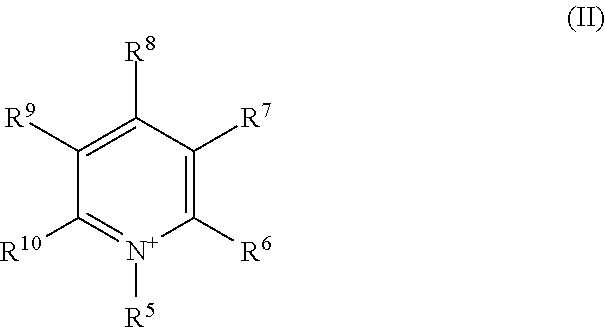Methyl-iodide-free carbonylation of an alcohol to its homologous aldehyde and/or alcohol
a technology of methyl iodide and alcohol, which is applied in the direction of carbon monoxide reaction carboxylic preparation, organic compound/hydride/coordination complex catalyst, physical/chemical process catalyst, etc., can solve the problem of undesirable co-product of methyl iodid
- Summary
- Abstract
- Description
- Claims
- Application Information
AI Technical Summary
Benefits of technology
Problems solved by technology
Method used
Image
Examples
example 1
[0145]A 100-mL Hastelloy® C autoclave was charged with a solution of (MePPh3)2CoI4 (1.236 mmol) in 25 mL of methanol, sealed and purged 3 times with N2. The reactor was pressurized to 6.9 MPa (1000 psig) with 1:1 CO:H2 and heated to 190° C. Upon reaching 190° C., the reactor was pressurized to a total pressure of 27.6 MPa (4000 psig) with 1:1 CO:H2. After 30 minutes the reactor was cooled to 5° C. and the gas was vented. The contents were analyzed by gas chromatography and the results are shown in Table 2.
example 15
[0149]Example 1 was repeated at a temperature of 195° C. and 0.025 mole % (MePPh3)2CoI4 catalyst as shown with the corresponding results in Table 3.
Comparative Examples C6-C8
[0150]Example 15 was repeated using the same total amount of catalyst, but varying the relative amounts of (MePPh3)2CoI4 and (MePPh3)2CoBr4 as given in Table 3. At the same total catalyst concentration, the Space Time Yield decreased from 9.8 with all (MePPh3)2CoI4 (Example 15) down to 2.5 with all (MePPh3)2CoBr4 (Comparative Example C8). These examples show that an iodide cation for catalyzing the reductive carbonylation of methanol to acetaldehyde equivalents produces a higher STY than a bromide cation.
example 16
[0151]Example 1 was repeated at a temperature of 195° C. and 0.2 mole % (MePPh3)2CoI4 catalyst as shown with the corresponding results in Table 3.
PUM
| Property | Measurement | Unit |
|---|---|---|
| pressure | aaaaa | aaaaa |
| temperature | aaaaa | aaaaa |
| pressure | aaaaa | aaaaa |
Abstract
Description
Claims
Application Information
 Login to View More
Login to View More - R&D
- Intellectual Property
- Life Sciences
- Materials
- Tech Scout
- Unparalleled Data Quality
- Higher Quality Content
- 60% Fewer Hallucinations
Browse by: Latest US Patents, China's latest patents, Technical Efficacy Thesaurus, Application Domain, Technology Topic, Popular Technical Reports.
© 2025 PatSnap. All rights reserved.Legal|Privacy policy|Modern Slavery Act Transparency Statement|Sitemap|About US| Contact US: help@patsnap.com



